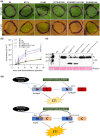AvrRps4 effector family processing and recognition in lettuce
- PMID: 35616618
- PMCID: PMC9366065
- DOI: 10.1111/mpp.13233
AvrRps4 effector family processing and recognition in lettuce
Abstract
During pathogenesis, effector proteins are secreted from the pathogen to the host plant to provide virulence activity for invasion of the host. However, once the host plant recognizes one of the delivered effectors, effector-triggered immunity activates a robust immune and hypersensitive response (HR). In planta, the effector AvrRps4 is processed into the N-terminus (AvrRps4N ) and the C-terminus (AvrRps4C ). AvrRps4C is sufficient to trigger HR in turnip and activate AtRRS1/AtRPS4-mediated immunity in Arabidopsis; on the other hand, AvrRps4N induces HR in lettuce. Furthermore, AvrRps4N -mediated HR requires a conserved arginine at position 112 (R112), which is also important for full-length AvrRps4 (AvrRps4F ) processing. Here, we show that effector processing and effector recognition in lettuce are uncoupled for the AvrRps4 family. In addition, we compared effector recognition by lettuce of AvrRps4 and its homologues, HopK1 and XopO. Interestingly, unlike for AvrRps4 and HopK1, mutation of the conserved R111 in XopO by itself was insufficient to abolish recognition. The combination of amino acid substitutions arginine 111 to leucine with glutamate 114 to lysine abolished the XopO-mediated HR, suggesting that AvrRps4 family members have distinct structural requirements for perception by lettuce. Together, our results provide an insight into the processing and recognition of AvrRps4 and its homologues.
Keywords: AvrRps4; XopO; effector-triggered immunity; hypersensitive response; processing; recognition.
© 2022 The Authors. Molecular Plant Pathology published by British Society for Plant Pathology and John Wiley & Sons Ltd.
Figures




References
-
- Bhattacharjee, S. , Halane, M.K. , Kim, S.H. & Gassmann, W. (2011) Pathogen effectors target Arabidopsis EDS1 and alter its interactions with immune regulators. Science, 334, 1405–1408. - PubMed
-
- Bigeard, J. , Colcombet, J. & Hirt, H. (2015) Signaling mechanisms in pattern‐triggered immunity (PTI). Molecular Plant, 8, 521–539. - PubMed
-
- Cesari, S. (2018) Multiple strategies for pathogen perception by plant immune receptors. New Phytologist, 219, 17–24. - PubMed
Publication types
MeSH terms
Substances
LinkOut - more resources
Full Text Sources
Molecular Biology Databases

